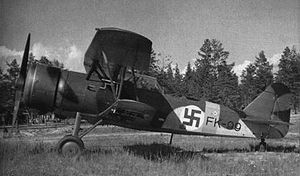Fokker C.X
| C.X | |
|---|---|
 | |
| Finnish Fokker C.X | |
| Role | Light reconnaissance, bomber aircraft |
National origin | Netherlands |
| Manufacturer | Fokker |
| Introduction | 1933 |
| Primary users | Royal Netherlands Air Force Finnish Air Force Republican Spanish Air Force |
The Fokker C.X was a Dutch biplane scout and light bomber designed in 1933. It had a crew of two (a pilot and an observer).
Contents
1 Design and development
2 Operational history
3 Variants
4 Operators
5 Specifications (C.X)
6 See also
7 References
7.1 References
7.2 Bibliography
Design and development
The Fokker C.X was originally designed for the Royal Dutch East Indies Army, in order to replace the Fokker C.V. Like all Fokker aircraft of that time, it was of mixed construction, with wooden wing structures and a welded steel tube frame covered with aluminium plates at the front of the aircraft and with fabric at the rear. The prototype was built in 1934 with a Rolls-Royce Kestrel V engine.
The East Indies Army ordered 13 C.Xs, but they were soon replaced in the scout/light bomber role by the American Martin B-10s. Until the Japanese attack on the Dutch East Indies in 1941, the C.X remained in use as a trainer and target tug.
The Dutch Air Force ordered 16 C.Xs, and later four more with Kestrel IIS engines. These four were later re-equipped with Kestrel V engines; the Kestrel IIS proved not very reliable.
Two C.Xs were delivered to the Spanish Republic, and four more to Finland. The Finns also license-produced 35 C.Xs until 1942. These C.Xs were equipped with Bristol Pegasus XII engines.
Airspeed Ltd. in Great Britain got a license to build C.Xs for the British market as the Airspeed AS.22, but no orders were received.[1]
Operational history
During the German attack on the Netherlands in May 1940, the C.Xs served in their intended role as scouts and light bombers. The tactic of "hugging the ground" allowed the C.Xs to achieve some success. Two C.Xs and their crews escaped to France after the Dutch surrender.
The Finnish C.Xs served with distinction in the Winter War, the Continuation War and the Lapland War. The C.X was the most important short-range reconnaissance aircraft and dive bomber of the Finnish Air Force at the outbreak of the Winter War. There were 29 of them in combat units, the "Frans-Kalle" was slow but possessed a robust airframe, making it a useful asset. the maximum dive speed was 540 km/h, which enabled it to break away from the Soviet I-153 and I-16 fighters. As hostilities continued, losses began to mount. During the Winter War 8 FKs were lost. The last of the seven Finnish C.Xs that survived the war crashed in 1958. The craft, designated FK-111, served as a target-towing craft in the Finnish Air Force. The plane crashed into a forest on 21 January 1958, killing the pilot (Second Lieutenant Aimo Allinen) and the winch-operator (2nd Ltn Antti Kukkonen).
Variants
C.X Series I : Fokker-built aircraft for the Dutch using an inline engine
C.X Series II : Fokker-built, 4 to Finland
C.X Series III: Licence-built in Finland, had modified upper wings which were slightly more swept.
C.X Series IV : Licence-built in Finland, 5 planes which were put together from spare parts.
Operators
 Finland
Finland
Finnish Air Force (39)
 Netherlands
Netherlands
Royal Netherlands Air Force (20)
Royal Netherlands East Indies Army Air Force (13)
 Spain
Spain
Republican Spanish Air Force (2)
Specifications (C.X)
Data from Bombers a guide to Bombers of World War II[2]
General characteristics
Crew: Two
Length: (Dutch) 9.2 m (Finnish) 9.1 m ((Dutch)30 ft 2.25 in (Finnish) 29 ft 9 in)
Wingspan: 12.00 m (39 ft 4.5 in)
Height: 3.30 m (10 ft 10 in)
Empty weight: (Dutch and Finnish) Approx 1,400 kg ((Dutch and Finnish) 3,086 lb)
Loaded weight: (Dutch) 2,250 kg (Finnish) 2,500 kg ((Dutch) 4,960 lb (Finnish) 5,512 lb)
Max. takeoff weight: 2,900 kg (6,393 lb)
Powerplant: 1 × (Dutch) Rolls Royce Kestrel liquid-cooled V12 (Finnish) License-built Bristol Pegasus XII nine-cylinder radial, (Dutch) 485 kW (Finnish) 634 kW ((Dutch) 650 hp (Finnish) 850 hp)
Performance
Maximum speed: (Dutch) 320 km/h (Finnish) 340 km/h ((Dutch) 199 mph (Finnish) 211 mph)
Range: (Dutch) 830 km (Finnish) 840 km ((Dutch) 516 mi (Finnish) 522 mi)
Service ceiling: (Dutch) 8,300 m (Finnish) 8,400 m ((Dutch) 27,230 ft (Finnish) 27,560 ft)
Rate of climb: 8.3 m/s ()
Armament
- 2 × 7.9 mm (.31 in) (7,7 mm in Finnish service) machine guns fixed in top of front fuselage and a third 7.9 mm (.31 in) (7.62 mm L-33/34 in Finnish service) manually aimed from rear cockpit
- Underwing racks for 2 × 175 kg (385 lb) or 4 × 100 kg (220 lb) bombs
See also
Related lists
- List of aircraft of World War II
- List of aircraft of the Spanish Republican Air Force
References
| Wikimedia Commons has media related to Fokker C.X. |
References
^ Taylor, H.A.. Airspeed Aircraft since 1931. Putnam. 1970. London. .mw-parser-output cite.citation{font-style:inherit}.mw-parser-output .citation q{quotes:"""""""'""'"}.mw-parser-output .citation .cs1-lock-free a{background:url("//upload.wikimedia.org/wikipedia/commons/thumb/6/65/Lock-green.svg/9px-Lock-green.svg.png")no-repeat;background-position:right .1em center}.mw-parser-output .citation .cs1-lock-limited a,.mw-parser-output .citation .cs1-lock-registration a{background:url("//upload.wikimedia.org/wikipedia/commons/thumb/d/d6/Lock-gray-alt-2.svg/9px-Lock-gray-alt-2.svg.png")no-repeat;background-position:right .1em center}.mw-parser-output .citation .cs1-lock-subscription a{background:url("//upload.wikimedia.org/wikipedia/commons/thumb/a/aa/Lock-red-alt-2.svg/9px-Lock-red-alt-2.svg.png")no-repeat;background-position:right .1em center}.mw-parser-output .cs1-subscription,.mw-parser-output .cs1-registration{color:#555}.mw-parser-output .cs1-subscription span,.mw-parser-output .cs1-registration span{border-bottom:1px dotted;cursor:help}.mw-parser-output .cs1-ws-icon a{background:url("//upload.wikimedia.org/wikipedia/commons/thumb/4/4c/Wikisource-logo.svg/12px-Wikisource-logo.svg.png")no-repeat;background-position:right .1em center}.mw-parser-output code.cs1-code{color:inherit;background:inherit;border:inherit;padding:inherit}.mw-parser-output .cs1-hidden-error{display:none;font-size:100%}.mw-parser-output .cs1-visible-error{font-size:100%}.mw-parser-output .cs1-maint{display:none;color:#33aa33;margin-left:0.3em}.mw-parser-output .cs1-subscription,.mw-parser-output .cs1-registration,.mw-parser-output .cs1-format{font-size:95%}.mw-parser-output .cs1-kern-left,.mw-parser-output .cs1-kern-wl-left{padding-left:0.2em}.mw-parser-output .cs1-kern-right,.mw-parser-output .cs1-kern-wl-right{padding-right:0.2em}
ISBN 0-370-00110-9
^ Gunston, Bill, An Illustrated guide to Bombers of World War II, Salamander.
ISBN 0-86101-069-8
Bibliography
- Taylor, H.A.. Airspeed Aircraft since 1931. Putnam. 1970. London.
ISBN 0-370-00110-9